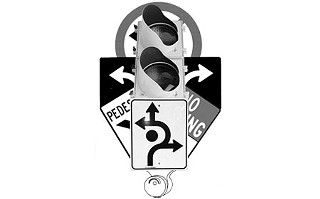It's so much easier riding through this cursed Windsor-Bayers Road intersection than dealing with those frigging time-delayed, push-button, anti-pedestrian crosswalks. And this intersection didn't even make the list of Halifax's seven worst, which my Facebook friends and Twitter followers came up with.
Today I'm traversing them all, by bicycle. I walk more than I bike, and sometimes I even drive a car, but cycling is the quickest way to hit all seven and learn what the fuss is about. For mid-sized city dwellers, Haligonians sure love to bitch about traffic, and I suspect our weird intersections, coupled with rush-hour funneling into the peninsula, have something to do with it.
Take Connaught and Chebucto. "It terrifies me every time," says a friend who walks this intersection daily, "the number of cars turning right on green that try to zoom in without even pausing to check for pedestrians." Her rant echoes in my head as I whip through the left turn unimpeded---no pedestrians at midday.
Next up: Chebucto/Cunard-Windsor, where the streets don't line up. I'm going straight but it feels like a short-right and then a short-left. On the Google Earth streetscape you can see the chaos of this intersection during a yellow light.
Now the dreaded Common. "Worst traffic design ever," a reader says. "Impossible to walk across, impossible to drive through."
I start with Cunard-Agricola/North Park. I make a left and grab this week's Coast at the office. The manoeuvre involves crossing in front of right-turning cars to get into the left side of the fork, then going straight. Make sense?
I double back and take the left lane behind a turning delivery truck with exhaust issues. I remember the advice of HRM's senior traffic operations guy, Taso Koutoulakis. "Bikes are nervous to get side-by-side with vehicles, but you have to take the lane," he told me when I asked him about Halifax's weirder intersections. "Some intersections are more complex than others and you have to exercise due caution." I wish the lead-foot whipping by from my rear right followed Koutoulakis' advice.
At the five-road convergence of North Park-Cogswell-Rainnie-Ahern-Trollope, where all who enter shall be dangerous drivers, I turn left onto Cogswell and double back, just to get the full experience. The city has wisely provided a green arrow to ease the flow, but the confusion remains for anyone unfamiliar with star-shaped intersections. And traffic gods help you if you want to swing around the mid-intersection lights onto Rainnie.
I head back for the trio of triage at Cogswell/Quinpool-Robie-Bell. The biggest criticism of this intersection is actually coming the other way (eastish-bound) off Quinpool. You have three lanes and three options: right lane hooks right onto Robie; middle lane goes straight onto Bell Road and left lane goes straight onto Cogswell. The problem is the options aren't clearly labelled, and being left to go straight is counterintuitive.
As for me, I'm turning left from Cogswell onto Robie, southbound. I hit the red, lose my patience and walk the bike across Cogswell and Bell. I see the distant walk sign on the other side and nearly get flattened as the Cogswell-Quinpool lights change. Oops, that walk light was for Bell Road, not Cogswell, even though it is essentially one bent crosswalk serving both.
I survive long enough to reach the south end and hit Seymour/Vernon-Coburg, another misaligned intersection. I guess I'm learning---I'm less confused than the Coburg drivers, one of whom is kind enough to stop and wave me through the stop sign.
For Halifax's worst, that wasn't so bad. But it wasn't rush hour. Are our notorious intersections really so unusually terrible?
Some planners I know point out that three or more road intersections aren't unique to Halifax. New York, Seattle, San Fransisco, Victoria, London and Paris all have them. They are usually the result of old organic urban growth---two different street grids started at different times colliding---rather than more modern grid planning.
Other cities, like Boston and Vancouver, have rerouted some roads to avoid such confusing and dangerous intersections. Planner Jeffrey Haggett says that "multi-road intersections can be an energetic urban form." Character-builders. "But they need to be planned properly."
Koutoulakis observes that "a popular treatment of these intersections is to convert them to roundabouts," which have a better safety record. That's because traffic all flows in the same direction, eliminating head-on collisions. But he says the city has "no immediate plans" to re-route its roads, which could cost millions per intersection. But hey, at least we've got character.
Halifax's worst intersections
View Halifax's worst biking and walking intersections in a larger map











